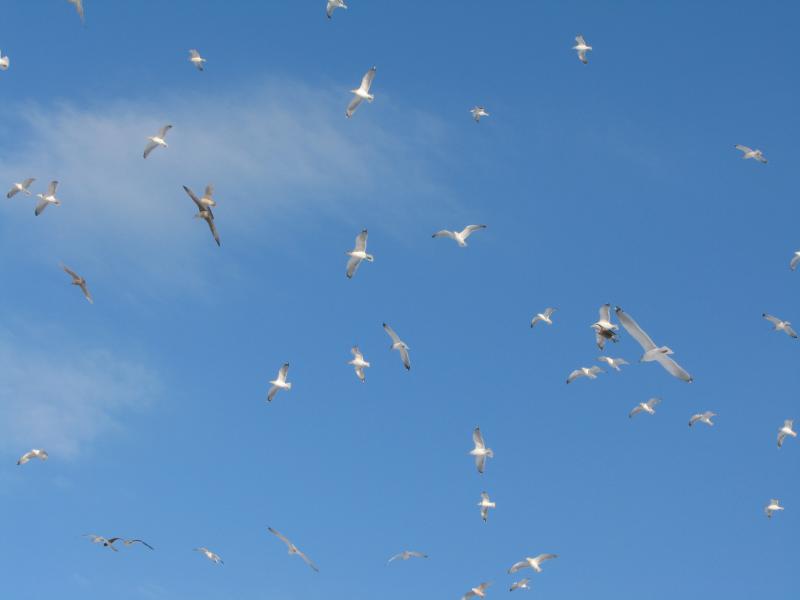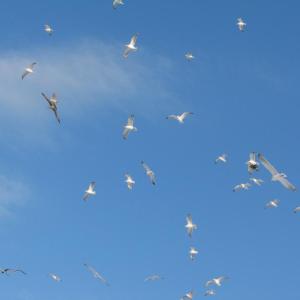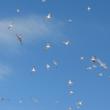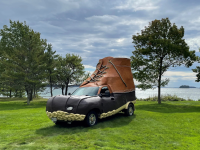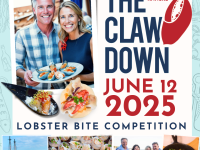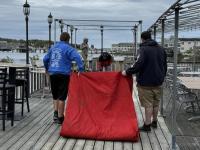Don’t Take Those ‘Seagulls’ for Granted
It’s pretty easy to take gulls for granted. They seem to be everywhere, ready to grab a lobster roll out of the hands of an unsuspecting visitor on the back deck of every local seafood place. Or squawking from the top of a building, boat, or wharf piling. Or strolling the shoreline looking for a crab, or the local soccer field searching for earthworms. Or soaring high overhead in an impossibly blue sky on a classic Maine day.
To the average person, gulls may seem to be one of the most common and least surprising of birds.
Yet the common gull that so many people refer to as the “seagull”—whose official name is herring gull, Larus argentatus—was once highly endangered as a breeding species in Maine. After a hundred years of unregulated taking of gull eggs at nesting islands and later the shooting of adult birds for their feathers for in decorating women’s hats, there were very few herring gulls left nesting on the islands of the Maine coast by the late 1800s. But in the early 1900s, the nascent Audubon movement hired some lighthouse keepers to also serve as wardens to protect birds nesting on a few Maine islands. Then in 1916, the Migratory Bird Treaty came to be, followed by the passage of the Migratory Bird Treaty Act here in the U.S. in 1918. That’s the 100-year old legislation that we, along with conservation groups, have been celebrating this year, the Year of the Bird.
Herring gulls and other seabirds began a steady rebound in numbers following these historic changes, and by 1931 there were an estimated 25,000 pairs nesting on 77 Maine islands. Numbers peaked in Maine in the mid-1990s at about 36,000 pairs but have since declined, with 25,000 pairs estimated in 2008. The larger species, the great black-backed gull, has also declined in recent years from 16,400 pairs in the mid-1990s to 9,500 pairs in 2008.
The decline in these large gulls is actually part of a broad national trend that is thought to be the result of two major changes in food availability: changes in fisheries and closure of landfills. Unregulated or poorly regulated offshore fisheries generated massive amounts of unmarketable fish and other sea creatures that were tossed overboard from the vessels. This discarded fish provided huge amounts of food for gulls. That changed in the last decades of the 1900s because certain fisheries collapsed, and because foreign vessels were excluded from fishing within 200 miles of our coasts.
Over this same time period, state and federal regulations and investments went into addressing the problem of household waste in order to protect water and air from contaminants. An amazing 10,000 open landfills across the U.S. and nearly 400 in Maine were closed from the 1970s into the 1990s. Those landfills were like fast food restaurants for gulls, and by the end of the 1990ss most were out of business. Between the loss of those landfill fast food restaurants and reductions in discarded fish, there just wasn’t as much food available for all those gulls. That’s the most likely explanation for the declines documented since the 1990s.
Of course, there may be all sorts of other factors impacting large gull populations—contaminants, climate change effects, increases in numbers of nestling predators like bald eagles, and perhaps others that will only become obvious as time goes on. Gulls are great indicator species to watch for changes in our environment that may not be obvious to us humans at first. By tracking changes in their numbers we may get an early warning sign about something happening that may eventually start impacting us humans as well.
Imagine the common “seagull” being the sentinel watching out for the health of us all!
Jeffrey V. Wells, Ph.D., is a Fellow of the Cornell Lab of Ornithology. Dr. Wells is one of the nation's leading bird experts and conservation biologists and author of the “Birder’s Conservation Handbook.” His grandfather, the late John Chase, was a columnist for the Boothbay Register for many years. Allison Childs Wells, formerly of the Cornell Lab of Ornithology, is a senior director at the Natural Resources Council of Maine, a nonprofit membership organization working statewide to protect the nature of Maine. Both are widely published natural history writers and are the authors of the popular book, “Maine’s Favorite Birds” (Tilbury House) and the newly released “Birds of Aruba, Bonaire, and Curaçao” from Cornell University Press.
Event Date
Address
United States

